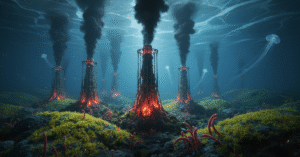Arctic hidden world life beyond earth is perhaps the most incredible recent discovery in deep-sea science, and it profoundly shook my understanding of life. For years, scientists believed the deep Arctic Ocean, covered by miles of thick, freezing ice, was a dead zone—a quiet, dark, and hostile place.
But new expeditions have proven them spectacularly wrong.
Scientists have recently uncovered a hidden, vibrant ecosystem in this hostile environment. This discovery doesn’t just rewrite our Earth’s geography; it fundamentally changes our search for life beyond Earth.
This incredible place, known as the Aurora Vent Field on the Gakkel Ridge, is so extreme, yet so full of life, that it is now considered a mirror for what might be happening deep inside icy moons like Saturn’s Enceladus and Jupiter’s Europa.
The Decades-Long Hunt for the Aurora Vents
The story of this discovery is one of perseverance and high-stakes exploration, much like finally unlocking a secret vault after years of searching.
We’ve known for over 20 years that the Gakkel Ridge—Earth’s slowest-spreading oceanic mountain chain—was a likely spot for hydrothermal activity.
The chemical traces were there, but the location was blocked by the most formidable natural barrier: permanent, thick Arctic ice. Sending an underwater vehicle (ROV) through drifting, crushing ice at 4,000 meters depth is arguably one of the toughest engineering feats on the planet.
Finally, in a series of ambitious expeditions in 2021 and follow-up studies in 2023, research teams were able to maneuver their robots to the seafloor. What they found was truly spectacular.

The Extreme Ecosystem: 350°C and a Wealth of Minerals
When the cameras finally reached the target depth, they weren’t met with a barren wasteland. Instead, the researchers saw a vibrant, active ecosystem—the Arctic hidden world life beyond earth has been hiding.
- Black Smokers: They discovered fragile, tall “black smoker” chimneys, some releasing superheated water up to 350°C (662°F). These vents spew a cocktail of dissolved metals, sulfur, and gases into the surrounding cold water.

Conceptual image by FACTOVATE (AI generated) - Unique Geology: The team was surprised to find that these chimneys were made of minerals, like Nickel (Ni) and Cobalt (Co), that typically only form deep inside Earth’s mantle. This suggested a more intense interaction between the seawater and the planet’s core than previously thought.
- Chemosynthetic Life: The most amazing part? Life was thriving without sunlight. Instead of photosynthesis, unique microbial communities use a process called chemosynthesis—they derive energy from the chemicals (like hydrogen and sulfide) emitted by the vents. This rich microbial mat forms the base of a completely isolated food chain.
Why This Matters for the Search for Extraterrestrial Life
For astrobiologists, this Arctic discovery is one of the most exciting findings in recent history.
The conditions at the Aurora Vent Field are believed to be the closest analogy on Earth to the environments we suspect exist on certain solar system bodies, making it a crucial training ground for future space missions.

Specifically, the existence of this Arctic hidden world life beyond earth is a strong argument for habitability on:
Enceladus (Saturn’s Icy Moon)
NASA and other space agencies believe that Enceladus has a deep, liquid ocean locked beneath its thick, icy shell.
The Cassini probe detected hydrogen gas and silica particles venting from its surface, strongly suggesting the presence of hydrothermal vents at its seafloor.
The Aurora Vents prove that life can not only survive but flourish in a permanently ice-covered ocean, powered by a core-driven chemical reaction. If life found a way under the Arctic, it could certainly find a way on Enceladus.
Europa (Jupiter’s Icy Moon)
Similar to Enceladus, Europa is also thought to harbor a massive subsurface ocean.
While we still need confirmation of active hydrothermal vents there, the fact that a chemically energized Arctic hidden world life beyond earth exists on our own planet gives scientists much higher confidence in the potential for simple, microbial life existing deep within Europa’s hidden oceans.
The Human Element: A Lesson in Humility and Persistence
When I look at this discovery, I feel a sense of profound humility. We often think we know everything about our own planet, but the Arctic reminded us that incredible secrets are still hiding in plain sight.
It took human ingenuity, years of planning, and enormous risk to breach that icy barrier and reveal this amazing Arctic hidden world life beyond earth.
The persistent study of these deep-sea vents, which are almost impossible to reach, is a testament to the human desire to seek out the unknown. Every discovery, whether it’s a new antibiotic or a city of hot springs beneath the ice, reminds us that the universe is far stranger, and perhaps far more alive, than we ever imagined. This story provides a perfect example of why science and exploration must continue.

